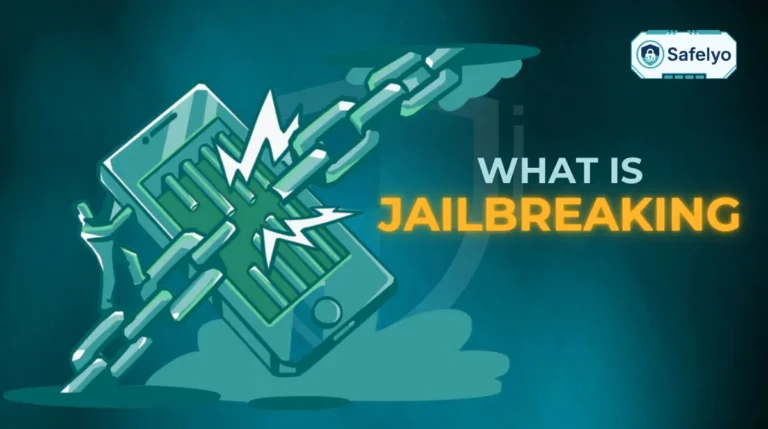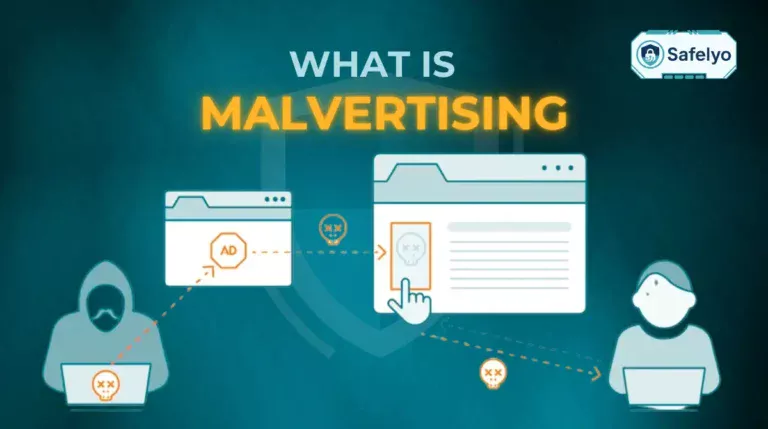Imagine a digital spy silently recording every character you type. That’s precisely what is a keylogger – a malicious tool designed to capture your passwords, credit card details, and private conversations without you ever knowing.
This threat is uniquely dangerous because it can come in two forms: a physical hardware device secretly plugged into your machine or an invisible piece of software lurking in the background. This makes it one of the most invasive forms of spyware today.
Having spent years in the cybersecurity field, I’ve seen the financial and personal damage these tools can cause. The worst part? Most victims have no idea they’re being watched until it’s too late. A keylogger isn’t just a virus; it’s a complete invasion of your privacy.
In this guide, I will arm you with the knowledge to fight back. You will learn:
- The critical differences between hardware and software keyloggers.
- The subtle warning signs that your device might be compromised.
- A step-by-step action plan to detect and remove these threats.
Your digital security starts here. Let’s dive in and learn how to protect yourself from this silent threat.
1. What is a keylogger exactly? And why should you be concerned?
Think of a keylogger as a digital eavesdropper for your keyboard. Its technical name is a “keystroke logger,” and its one and only mission is to secretly record every single key you press.
The goal is always the same: to capture your most sensitive information. This isn’t just about someone reading your emails; it’s about stealing the very keys to your digital kingdom, such as:
- Your online banking and email passwords
- Credit card numbers and their security codes
- Private messages on social media or chat apps
- Confidential business information
What makes a keylogger so frightening is its silence. Unlike a “loud” virus that might crash your computer or flood you with pop-ups, a keylogger is designed to be invisible. It doesn’t want you to know it’s there. Its purpose isn’t to break your device, but to quietly steal from you while you go about your day.
From my experience at Safelyo, I’ve seen firsthand that most people only realize they’re a victim when the damage is done – when their bank account is suddenly empty, or their identity has been compromised. This is why understanding this threat is the first critical step toward protecting yourself.
2. The two faces of keyloggers: Hardware vs. software
Not all keyloggers are created equal. To truly understand the threat, you need to know that they come in two fundamentally different forms: one is a physical object you could hold in your hand, and the other is an invisible program hiding on your device.
2.1. Hardware keyloggers: The physical threat
A hardware keylogger is a physical device that is physically connected to your computer to intercept keystrokes. Because it’s not a piece of software, it is completely invisible to antivirus scans. You have to find it with your own eyes.
The most common types include:
- USB/PS/2 connectors: These are the most frequent culprits. They look like a small adapter or a thumb drive and are placed between the keyboard cable and the computer’s port. An unsuspecting user would barely notice it.
- Keyboard overlays: These are thin, flexible membranes designed to fit perfectly over a laptop’s keyboard. They capture key presses as you type directly on them.
- Internal hardware modules: This is the most devious type, as it requires opening the computer’s case and soldering a small chip directly onto the motherboard.
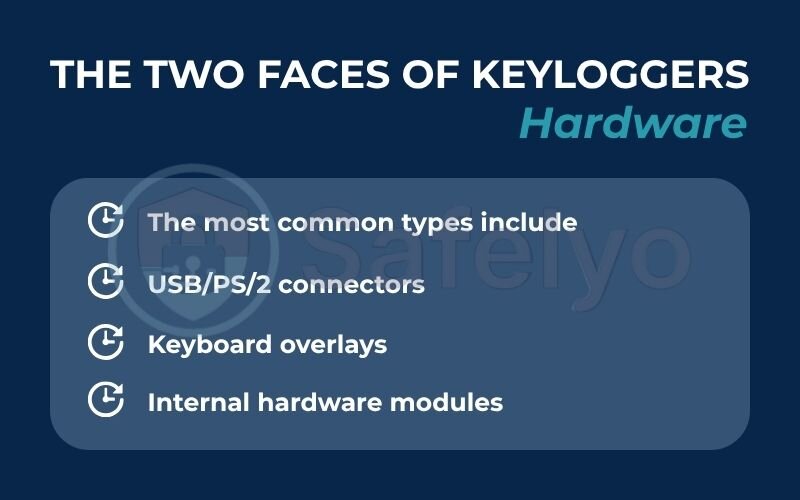
A simple real-world example: Imagine you’re using a public computer at an airport or library to quickly check your email. A thief could have walked by minutes earlier and plugged a tiny, discreet USB keylogger into the back of the PC tower. Everything you type – your username, your password, your credit card info for a flight booking – is now stored on that tiny device, waiting for the thief to come back and collect it.
2.2. Software keyloggers: The invisible spy
This is the most common type of keylogger you’ll encounter. A software keylogger is a computer program installed on your device’s operating system. It works like a spy hiding in the shadows of your system’s processes.
Think of it like this: It’s as if a tiny, invisible assistant is living inside your computer. This assistant has a notepad and is programmed to write down everything you type, which application you typed it in, and at what time.
Unlike their hardware cousins, software keyloggers are far more advanced. They can:
- Record all your keystrokes.
- Take screenshots of your screen at regular intervals.
- Log the contents of your clipboard (anything you copy and paste).
- Automatically email a detailed report of all your activity to the attacker. They don’t even need to be near your computer to get your data.

Because they are software, they can be installed remotely through phishing emails, malicious downloads, or other malware. The good news? A reputable antivirus or anti-malware program is designed to detect and remove them.
2.3. Key differences at a glance
To make it even clearer, here’s a simple side-by-side comparison to help you quickly distinguish between the two.
| Feature | Hardware Keylogger | Software Keylogger |
|---|---|---|
| Installation Method | Requires physical access to the device. | Can be installed remotely (phishing, malware). |
| Antivirus Detection | No. Cannot be detected by security software. | Yes. It can be detected and removed by an antivirus. |
| Data Retrieval | The attacker needs physical access to retrieve the device. | Data can be sent to the attacker remotely via the internet. |
| Commonality | Less common, used in targeted attacks. | Very common, used in widespread attacks. |
3. How do keyloggers get on your devices?
A keylogger can’t spy on you unless it gets onto your computer first. Unfortunately, cybercriminals have developed several sneaky methods to make this happen. Here are the most common entry points:
Phishing emails
This is by far the most popular delivery method. You receive an email that looks legitimate – perhaps a shipping notification from FedEx, a security alert from your bank, or an invoice from a supplier. The email pressures you to either click a malicious link or open an infected attachment (like a PDF or Word document). The moment you do, the keylogger installs itself. Think of it as willingly unlocking your front door for a thief disguised as a mailman.
Trojans
Just like the mythical Trojan Horse, this type of malware disguises a keylogger as something useful or desirable. You might download a free screen-saver, a game, or what you think is a legitimate software update from an untrustworthy website. The program you wanted might even work, but hidden inside it is a keylogger that gets installed right alongside it.
Drive-by downloads
This is a particularly scary method because it can happen without you clicking anything specific. You could simply visit a legitimate website that has been hacked by criminals. The compromised site can exploit an outdated plugin or vulnerability in your web browser to automatically download and install a keylogger onto your system.
Direct physical installation
This method is straightforward. Someone with physical access to your computer – a disgruntled colleague, a suspicious partner, or anyone who can touch your machine while it’s unlocked – can install a keylogger in minutes. They can either plug in a hardware keylogger or quickly install the software version from a USB drive.
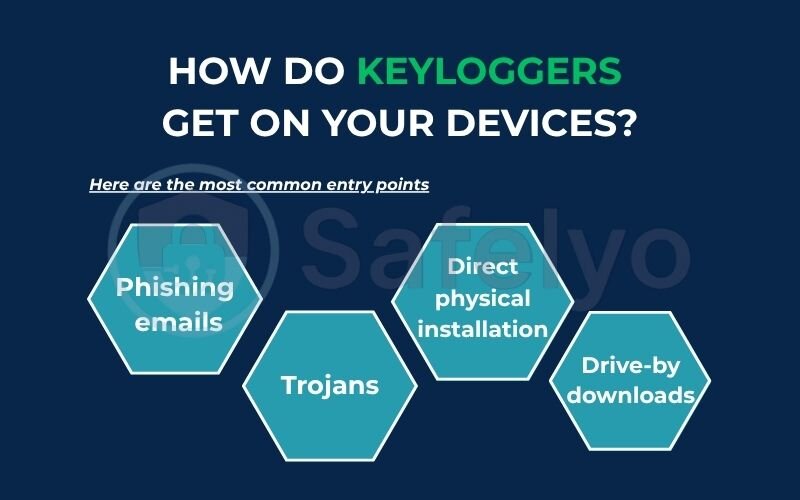
It’s no surprise that, according to reports like the Verizon Data Breach Investigations Report (DBIR), phishing consistently ranks as one of the top ways criminals distribute malware. Their success relies on tricking you, the user, into making a small mistake.
4. Warning signs: How to detect a keylogger on your system
Detecting a keylogger can sometimes feel like trying to spot a ghost. The most sophisticated ones are designed to be completely invisible. However, less advanced or poorly coded keyloggers can sometimes cause performance issues that you might notice if you pay close attention.
Here are a few potential red flags, but please read my important note at the end.
Your computer suddenly feels sluggish.
Web pages take longer to load, your browser freezes for no reason, or your whole system just feels like it’s running through mud. This can happen because the keylogger is using up system resources to record and send your data.
There’s a noticeable delay when you type.
This is a classic sign. You type a sentence, but the characters appear on the screen a second or two behind your fingers. It’s as if the computer is struggling to keep up with you, possibly because the keylogger is busy intercepting every press.
Your mouse cursor moves on its own, or things get clicked randomly.
While this is more often a sign of a different type of malware called a Remote Access Trojan (RAT), some keyloggers are bundled with other spyware that can cause this bizarre behavior.
You see strange error messages or graphics.
If you notice pop-ups with garbled text or your screen glitches when you’re typing in certain fields (like a password box), it could be a sign of a keylogger interfering with your system’s normal operations.
Your browser’s homepage or search engine has changed.
You open your browser expecting to see Google, but instead, you’re greeted by a weird search engine you’ve never heard of. This is a common symptom of many types of malware, including keyloggers.
Now, I have to be very clear about this. From years of analyzing malware threats, the most important lesson I’ve learned is this: do not rely only on these warning signs.
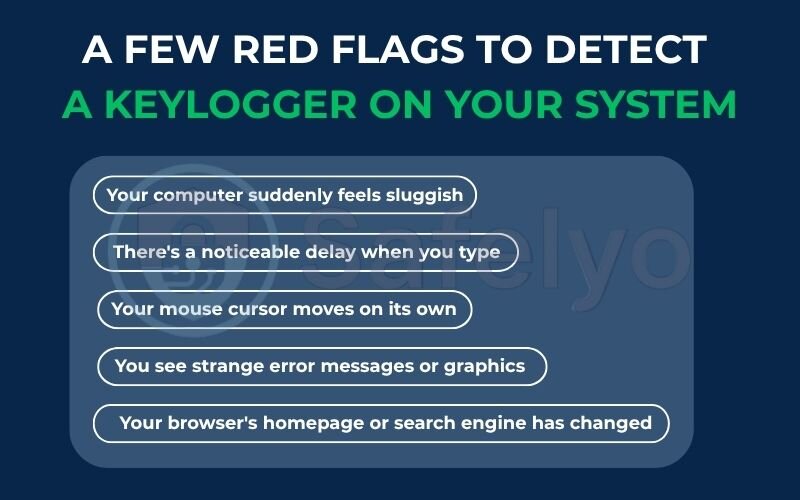
The cheap, amateur keyloggers might cause these glitches, but the professional-grade ones used by serious criminals are incredibly efficient. They are optimized to use minimal resources, so you won’t notice a thing. The absence of symptoms is not proof of safety; it’s often a sign of a more sophisticated threat. That’s why using dedicated security tools isn’t just a recommendation – it’s a necessity.
Read more:
5. Your action plan: How to remove and protect against keyloggers
Knowing about the threat is one thing; fighting back is another. If you suspect a keylogger is on your device or simply want to proactively defend yourself, here is a straightforward action plan. I’ve used these steps countless times to help people clean their systems and regain their peace of mind.
Run a comprehensive system scan.
This is your number one weapon against software keyloggers. Don’t rely on a basic, free antivirus. You need a powerful, reputable anti-malware suite like Malwarebytes or a top-tier antivirus like Norton or Bitdefender. Run a “full system scan,” not just a quick scan. This will comb through every file on your computer to find and quarantine the keylogger. This is the first and most critical step.
Physically inspect your connections.
Remember hardware keyloggers? Software can’t find them. You need to do a physical check. Unplug your computer and carefully examine all the ports. Look for any strange devices connected between your keyboard and the PC tower. Does that USB plug look unusually long or bulky? Is there anything attached that you didn’t put there? If you find something suspicious, unplug it immediately.
Keep everything updated.
This sounds simple, but it’s incredibly effective. Cybercriminals often exploit known security holes in outdated software. Regularly update your operating system (Windows, macOS), your web browser, and other programs. These updates frequently contain security patches that close the very doors keyloggers use to get in. Think of it as fixing the broken locks on your digital house.
Use an on-screen keyboard for critical logins.
This is a fantastic trick for an extra layer of security. Most operating systems (including Windows and macOS) have a built-in “On-Screen Keyboard.” When you need to enter your bank password or other highly sensitive credentials, use your mouse to click the characters on this virtual keyboard instead of typing them. Most keyloggers are designed to record physical keystrokes, so they won’t be able to capture what you enter this way.
Enable your firewall.
A firewall acts as a digital gatekeeper for your computer’s internet connection. It monitors incoming and outgoing traffic. While it might not stop a keylogger from being installed, a properly configured firewall can block the keylogger from “phoning home” – that is, sending your stolen data out to the attacker over the internet.
Be paranoid about links and downloads.
This is less of a technical tip and more of a behavioral one, but it’s the most important for prevention. Treat every unsolicited email with suspicion. Never click on links or download attachments from unknown senders. If you get a “problem with your account” email from a service like Amazon or PayPal, don’t click the link in the email. Instead, open a new browser tab and manually type in the website’s address to log in and check.
6. Are keyloggers legal?
This is a question I get asked surprisingly often, and the answer isn’t a simple yes or no. The legality of a keylogger depends entirely on consent and intent. Think of it like a security camera: it’s perfectly legal to install one on your own property to monitor for intruders, but it’s illegal to hide one in your neighbor’s house.
The context is everything. Here’s how it typically breaks down.
6.1. Legitimate uses of keyloggers
In some specific scenarios, using a keylogger is considered legal, provided certain conditions are met.
- Parental control: Parents may use keyloggers on computers they own to monitor their underage children’s online activity. The goal here is safety – to protect them from online predators, cyberbullying, or accessing inappropriate content.
- Employee monitoring: A company might install keyloggers on company-owned devices to ensure productivity, protect sensitive company data from being leaked, or for IT security purposes. However, in most regions, the company must explicitly state this monitoring in its employee handbook or IT policy. The key is transparency; employees need to be aware that their activity on company property is being monitored.
- IT troubleshooting: A system administrator might use a keystroke logger temporarily to diagnose a bizarre software bug that’s difficult to replicate. For instance, if an application only crashes after a specific sequence of inputs, a logger can help identify the problem.
6.2. When keyloggers are illegal
The line is crossed the moment a keylogger is installed on a device without the owner’s knowledge and consent for malicious purposes. It is absolutely illegal to use a keylogger to:
- Steal passwords, credit card numbers, or banking information.
- Spy on a spouse, partner, or any other adult without their explicit permission.
- Eavesdrop on private conversations or corporate secrets.
In short: if you own the device and are monitoring its use for legitimate protective reasons (like with your child or within a clear corporate policy), it’s generally legal. If you are installing it on someone else’s device secretly to steal from them or spy on them, you are breaking the law. Always check your local laws, as privacy regulations can vary.
7. What about keyloggers on Android and iPhone?
Yes, keyloggers absolutely exist for mobile devices, and you should be just as cautious. While Apple’s and Google’s official app stores have strong security measures, these threats typically find their way onto phones through a few specific methods:
- Malicious apps from unofficial sources: If you download an app from a third-party website instead of the official Google Play Store or Apple App Store (a practice called “sideloading”), you are at a much higher risk of installing malware.
- Fake keyboard apps: A common trick is to offer a “custom” keyboard app that promises fun emojis or themes. Once you permit it to be your default keyboard, it can record everything you type.
- Jailbreaking or rooting: If you’ve modified your phone to remove its built-in security restrictions, it becomes far more vulnerable to all kinds of malware, including keyloggers.
The warning signs on mobile are often related to performance: unusually fast battery drain, the device feeling hot to the touch, and a noticeable slowdown in performance. The best defense is simple: stick to official app stores and always be skeptical of apps that ask for excessive permissions.
8. FAQ about keylogger
Here are some of the most common questions we get at Safelyo about keyloggers, answered quickly and directly to give you the essential information you need.
How do I know if I have a keylogger?
You might notice your computer is unusually slow, there are delays when you type, or your browser acts strangely. However, the most dangerous keyloggers show no signs at all. The only truly reliable way to know if you have a software keylogger is to run a full system scan with a high-quality anti-malware program. For hardware keyloggers, you must physically inspect your computer’s ports and cables.
Can you get rid of a keylogger virus?
Yes, you absolutely can. For a software keylogger (which is what most people mean by “keylogger virus”), a powerful antivirus or anti-malware tool is designed to find and remove it. For a hardware keylogger, you simply need to find the physical device plugged into your computer and unplug it.
What is keystroke technology?
Keystroke technology is a broad term for any software or hardware that captures keyboard inputs. It’s not inherently good or bad. For example, it’s used for positive things like creating keyboard shortcuts or for accessibility features in operating systems. It only becomes malicious when used without consent for surveillance, in the form of a keylogger.
What is a keylogger in a cybersecurity context?
In a cybersecurity context, a keylogger is defined as a form of surveillance malware (spyware) used for the covert monitoring and recording of a user’s keystrokes. Its primary threat is data exfiltration, enabling attackers to steal credentials, financial information, and other sensitive data directly from the input source, bypassing many other security measures.
Can an antivirus detect all types of keyloggers?
Antivirus software is very effective at detecting and removing software keyloggers. However, it is completely blind to hardware keyloggers, as they are physical devices that leave no software footprint on your system.
Is resetting my PC to factory settings enough to remove a keylogger?
A full factory reset will erase all programs from your hard drive, which will almost certainly remove a software keylogger. However, it will have zero effect on a hardware keylogger, which must be physically found and removed.
What is the difference between a keylogger and spyware?
A keylogger is a specific type of spyware. Think of it this way: “spyware” is a broad category, like the word “vehicle.” A keylogger is a specific tool within that category, like the word “car.” All keyloggers are spyware, but not all spyware is are keylogger.
9. Conclusion
You now understand what is a keylogger and the silent, serious threat it poses to your digital privacy and financial security. By being aware of how they work and how they spread, you have already taken the most important step toward protecting yourself. This knowledge transforms you from a potential target into a prepared defender.
To stay safe, always remember these key points:
- Keyloggers have two faces: Physical hardware that you must find with your eyes, and invisible software that security tools must find.
- They get in through deception: Most keyloggers are installed via phishing emails, trojans, or malicious downloads. Vigilance is your first line of defense.
- Protection is a team effort: A combination of powerful security software, regular system updates, and your own cautious online habits is the only way to ensure comprehensive protection.
Don’t wait until your information has been stolen. Being proactive is your best defense against this hidden threat. To ensure you’re fully protected, Safelyo is here to help. Explore our in-depth reviews in our Antivirus category and choose the right shield for your digital life.



